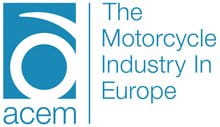Europe is moving towards connected and automated mobility. Future traffic mix should cater for the needs of vulnerable road users including motorcyclists. Regardless of their degree of automation, passenger cars and other vehicles must be able to recognise motorcycles and their inherent complex manoeuvres and react accordingly.
ACEM is convinced that advanced vehicle technology, including new ITS solutions, can make a valuable contribution to motorcycle safety, but this is not enough. Well-designed and properly maintained infrastructure as well as responsible and well-trained road users are also part of the solution. Only a genuinely safe system approach to motorcycle safety can deliver tangible and long-lasting safety improvements.
All stakeholders including policy makers, public authority, industry and user organisations are part of the solution. By working together, it will be possible to create a safer environment for motorcyclists across Europe.
The motorcycle industry fully supports the 4th Global Ministerial Conference on Road Safety declaration calling leaders and experts to accelerate action towards the Sustainable Development Goals’ target of halving global road deaths by 2030.
In line with the United Nations High-Level Political Forum’s pledge Member States should set targets to reduce fatalities and serious injuries, for all groups of road users and especially vulnerable road users such as pedestrians, cyclists and motorcyclists and users of public transport.



